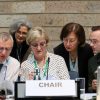Tuesday, May 21, 2024
News and Views from the Global South
Q&A: 'To Recall Is to Learn'
Interview with Liz Sevcenko, Historic Site Museums of Conscience
- Places that remember the Gulag across Russia and those that recall state terrorism in South America are not that different. They might find that in some ways their histories run parallel, and their role in the present time is similar.
Sevcenko is director of the International Coalition of Historic Site Museums of Conscience, based in New York. The Coalition brings together a number of historic sites of mass crimes, or where struggles took place for justice and human rights.
Almost ten years ago, the Lower East Side Tenement Museum in New York sent out a call to people at historic sites around the world, suggesting that they could have a critical role to play in promoting democratic engagement on pressing social issues.
Eight sites responded to the museum's call. Among these were the District Six Museum in South Africa, remembering forced removal under apartheid; the Gulag Museum, the only Stalinist labour camp to be preserved in Russia; the Liberation War Museum in Bangladesh, that recalls the genocide against Bangladeshi people during the liberation war of 1971; and the Senegalese Maison Des Esclaves, an 18th century slave transport station.
Other sites followed, from Argentina to the Czech Republic, and including the Monte Sole Peace School Foundation in Italy. Today, the International Coalition is led by 17 'Sites of Conscience' and includes more than 150 members and 1,800 supporters in 90 countries.
Italy is home to this year's summit of the Coalition (Jun. 16-20).
IPS: Why did the Coalition choose to organise its summit in Italy?
LS: The International Coalition came to Italy to learn from the model of the Monte Sole Peace School Foundation, one of the Coalition's accredited Sites of Conscience.
Monte Sole was the site of a Nazi massacre in 1944, carried out with assistance from Italian fascists. More than 700 people were killed, and several villages destroyed in the area.
The Peace School has developed innovative programmes that use the difficult history of this place to foster dialogue, particularly among young people, on contemporary issues of violence, racism, and xenophobia.
IPS: What is the role of these historic sites in the construction of a human rights culture today?
LS: Historic sites help us remember both painful and positive events and experiences that have shaped the state of human rights in our societies today. As in the case of the Terezín Memorial in the Czech Republic, a Gestapo prison during the Nazi occupation of the Czech part of Czechoslovakia in the Second World War.
But on their own, these historic sites do not automatically build a culture of human rights. We must make a deliberate and conscious effort to activate historic sites through innovative programming that brings people together across difference to reflect on the past and discuss how we can confront its contemporary legacies.
IPS: How does this work for the Terezín Memorial?
LS: The Terezin Memorial brings students and teachers from across the Czech Republic to reflect on the individual stories from this holocaust ghetto, and to consider the questions of personal responsibility they raise. But it does not stop there. It works with students and teachers to identify specific issues of racism or violence emerging in their schools and communities today, and what young people can do about them.
Through these kinds of programmes, members of the Coalition define themselves not only as sites of memory, but Sites of Conscience.
IPS: What can people – particularly young people – learn from these places?
LS: Young people, all people for that matter, struggle with different challenges to human rights, whether gross, visible violations or more insidious, incremental threats.
By exploring examples from the past, Sites of Conscience offer ways for us to understand the steps and individual decisions that develop cultures of tolerance and intolerance. Moreover, they relate larger social questions to each person's individual power and responsibility.
With this foundation, they help young people identify the roles they can play as individuals to address the difficult issues we face today.
For instance, Monte Sole Peace School's 'Peace in 4 Voices' residential summer camp brings together 40 youth from current or past conflict regions – such as Germany, Italy, Israel, and Palestine – who use the history of the violent conflict at Monte Sole to address their own experiences.
IPS: What is the connection between old struggles and current challenges such as racism and rising xenophobia, and what remains of the past struggles?
LS: Some Sites of Conscience address contemporary issues that are directly, or literally, linked to what happened there in the past.
The Lower East Side Tenement Museum preserves the apartments of 19th and 20th century immigrants to New York, using the stories of their daily lives as the catalyst for 'kitchen conversations', public dialogues on how immigration experiences are similar or different from the past to the present, and how they could be made better.
Other sites confront issues that have taken a totally new form. For instance, a Site of Conscience like Monte Sole Peace School does not inform people about this one event from the Second World War, but helps people analyse the underlying systems or cultures that enabled this violence to be unleashed.
While there may be no imminent threat of a massacre by an occupying army in Italy today, the Peace School uses the story of Monte Sole to examine cultures of violence and intolerance developing today that could lead to violence, or has already caused violence, against certain groups of people.
In both of these contexts, anti-immigrant sentiment and violence is on the rise. Sites offer many different ways for people to draw connections between past struggles and current issues, and we are also continually challenging ourselves to identify where issues are taking new forms and how we can address them.
IPS: What are the challenges Sites of Conscience face today?
LS: In some contexts, it may appear that the struggle a site remembers has been resolved. In fact, many governments and societies choose to commemorate sites specifically to signal that an issue has been resolved and does not need to be brought up again.
For instance, a visitor to Villa Grimaldi – a former clandestine centre of torture and detention in Chile – might believe that because Chile is now a democracy and this official system of repression has been eradicated, the issue of human rights in Chile has been resolved.
But the Corporacion Parque por la Paz Villa Grimaldi in Chile uses the history of its site to help young people identify the very different human rights issues they themselves are facing in school today – like xenophobia and bullying – and by what steps cultures of violence and repression can develop.
In this way, the site helps young people make connections between state authoritarianism, the repression of human rights, and present-day conflict.
IPS: Is such a connection normally accepted?
LS: While sites often receive support for preserving the fabric of their buildings or for telling simple stories about the past, they can face opposition to the much more difficult work of opening dialogue about the complexities and contradictions of history, and for refusing to relegate human rights issues to the past, refusing to categorise them as permanently resolved.
Instead, Sites of Conscience seek to inspire new generations to identify for themselves the issues of their own generation and be equipped to address them.
IPS: Is there any kind of cooperation among the European memory sites or are you working on this?
LS: We're absolutely thrilled that our international summit this year is bringing together a diversity of places of memory in Europe.
Our hope is that by the end of the summit, with Monte Sole's leadership, we will launch our first European Sites of Conscience project. At the summit, the sites from across Europe will explore how they can take active steps to address the specific and most urgent challenges facing Europe today; how they can support each other by working together to address these challenges, and how the International Coalition can support their efforts.

 Print
Print




